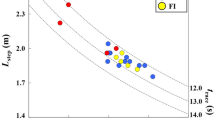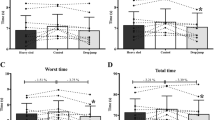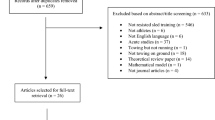Abstract
This study aimed to compare the effects of synchronous (SYN) vs asynchronous (ASY) modes of wheelchair propulsion in field sprint tests on performance and biomechanical parameters. Seven elite wheelchair basketball players performed two separate (SYN and ASY) straight-line 20-m sprints. ASY increased sprint time and decreased push frequency compared to SYN (p < 0.05). Peak velocity and total force for the mean of the last three pushes were higher in SYN. Rate of rise was higher in SYN for the first, second and third pushes (p < 0.05). No significant difference was found for peak power and mean work. SYN mode induces better performance (13% difference in speed). However, the increase in rate of rise, thus the expansion of the total force when gripping the hand rim, push frequency and total force in SYN modes seems to expand the risk of developing musculoskeletal disorders during manual wheelchair propulsion for upper limb joints than ASY.







Similar content being viewed by others
References
Vanlandewijck Y, Theisen D, Daly D (2001) Wheelchair propulsion biomechanics: implications for wheelchair sports. Sports Med 31:339–367
Bayley JC, Cochran TP, Sledge CB (1987) The weight-bearing shoulder. The impingement syndrome in paraplegics. J Bone Joint Surg Am 69:676–678
Boninger ML, Cooper RA, Baldwin MA, Shimada SD, Koontz A (1999) Wheelchair pushrim kinetics: body weight and median nerve function. Arch Phys Med Rehab 80:910–915
Goosey-Tolfrey VL, Kirk JH (2003) Effect of push frequency and strategy variations on economy and perceived exertion during wheelchair propulsion. Eur J Appl Physiol 90:153–158
Glaser RM, Sawka MN, Young RE, Suryaprasad AG (1980) Applied physiology for wheelchair design. J Physiol 48:41–44
Lenton JP, Fowler N, van der Woude L, Goosey-Tolfrey VL (2008) Efficiency of wheelchair propulsion and effects of strategy. Int J Sports Med 29:384–389
Lenton JP, Van der Woude L, Fowler N, Goosey-Tolfrey VL (2009) Effects of arm frequency during synchronous and asynchronous wheelchair propulsion on efficiency. Int J Sports Med 30(4):233–239
Faupin A, Borel B, Meyer C, Gorce P, Watelain E (2013) Effects of synchronous versus asynchronous mode of propulsion on wheelchair basketball sprinting. Disabil Rehabil Assist Technol 8:496–501
Lenton JP, Van der Woude L, Fowler N, Nicholson G, Goosey-Tolfrey V (2014) Hand-rim forces and gross mechanical efficiency in asynchronous and synchronous wheelchair propulsion: a comparison. Int J Sports Med 35:223–231
Boninger ML, Baldwin M, Cooper RA, Koontz A, Chan L (2000) Manual wheelchair pushrim biomechanics and axle position. Arch Phys Med Rehab 81:608–613
International Wheelchair Basketball Federation (2014) Functions of the classification commission. IOP publishing IWBF. http://www.iwbf.org/index.php/2014-08-31-08-38-47/2014-08-31-08-39-32/functions-of-the-classification-commission. Accessed 12 July 2016
Cowan RE, Boninger ML, Sawatzky BJ, Mazoyer BD, Cooper RA (2008) Preliminary outcomes of the smartwheel users’ group database: a proposed framework for clinicians to objectively evaluate manual wheelchair propulsion. Arch Phys Med Rehab 89:260–268
Mason BS, van der Woude LHV, Lenton JP, Goosey-Tolfrey VL (2012) Effects of wheel and hand-rim size on sub-maximal propulsion in wheelchair athletes. Med Sci Sports Exercise 44:126–134
Three Rivers Holdings LLC (2013) SmartWheel user’s guide 2014. Mesa, Arizona
Asato K, Cooper RA, Robertson RN, Ster JF (1993) SMARTWheel: development and testing of a system for measuring manual wheelchair propulsion dynamics. IEEE Trans Biomed Eng 40:1320–1324
Cooper RA, Robertson RN, Van Sickle DP, Boninger ML (1997) Methods for determining three-dimensional wheelchair pushrim forces and moments: a technical note. J Rehabil Res Dev 34:162–170
Robertson RN, Boninger ML, Cooper RA, Shimada SD (1996) Pushrim forces and joint kinetics during wheelchair propulsion. Arch Phys Med Rehab 77:856–864
Brasile FM (1986) Wheelchair basketball skills proficiencies versus disability classification. Adapt Phys Act Q 3:6–13
Vanlandewijck Y, Spaepen A, Lysens R (1995) Relationship between the level of physical impairment and sports performance in elite wheelchair basketball athletes. Adapt Phys Act Q 12:139–150
Niesing R, Eijskoot F, Kranse R, den Ouden AH, Storm J, Veeger HEJ, van der Woude LHV, Snijders CJ (1990) Computer-controlled wheelchair ergometer. Med Biol Eng Comput 28:329–338
Woude van der LHV, Groot de S, Hollander AP, Ingen Schenau van GJ, Rozendal RH (1986) Wheelchair ergonomics and physiological testing of prototypes. Ergonomics 29:1561–1573
Veeger HEJ, Van der Woude L, Rozendal RH (1989) Wheelchair propulsion technique at different speeds. Scand J Rehabil Med 21:197–203
Boninger ML, Cooper RA, Shimada SD, Rudy TE (1997) Shoulder and elbow motion during two speeds of wheelchair propulsion: a description using a local coordinate system. J Spinal Cord Med 35:135–144
Vegter RJ, Lamoth CJ, de Groot S, Veeger DH, van der Woude LH (2013) Variability in bimanual wheelchair propulsion: consistency of two instrumented wheels during handrim wheelchair propulsion on a motor driven treadmill. J Neuroeng Rehabil 10:9
Boninger ML, Cooper RA, Robertson RN, Shimada SD (1997) Three-dimensional pushrim forces during two speeds of wheelchair propulsion. Am J Phys Med Rehabil 76:420–426
Dallmeijer AJ, Van der Woude L, Veeger HE, Hollander AP (1998) Effectiveness of force application in manual wheelchair propulsion in persons with spinal cord injuries. Am J Phys Med Rehabil 77:213–221
Rozendaal RH, Veeger HEJ, Van der Woude L (2000) The push force pattern in manual wheelchair propulsion as a balance between cost and effect. J Biomech 36:239–247
Veeger HEJ (1999) Biomechanics of manual wheelchair propulsion. In: Van der Woude LH, Hopman MT, van Kemenade CH (eds) Biomedical aspects of manual wheelchair propulsion: The state of the art II. Amsterdam, pp 86–95
Veeger HEJ, Van der Woude L, Rozendaal RH (1992) Effect of handrim velocity on mechanical efficiency in wheelchair propulsion. Med Sci Sports Exerc 24:100–107
van der Scheer JW, de Groot S, Vegter RJ, Veeger DH, van der Woude LH (2014) Can a 15 m-overground wheelchair sprint be used to assess wheelchair-specific anaerobic work capacity? Med Eng Phys 36:432–438
Acknowledgments
The authors thank the athletes and their coaches for their participation in this study. Warm thanks as well to the “Fédération Française Handisport” (FFH) and the “Comité Régional Handisport Côte d’Azur” (CRH CA) for collaborating in this study. We also thank the “Institut National du Sport, de l’Expertise et de la Performance” (INSEP) and the region Provence-Alpes-Côte d’Azur for their financial contribution.
Author information
Authors and Affiliations
Corresponding author
Ethics declarations
Conflict of interest
The authors report no conflicts of interest. The authors alone are responsible for the content and writing of this article.
Rights and permissions
About this article
Cite this article
Astier, M., Weissland, T., Vallier, J.M. et al. Effects of synchronous versus asynchronous push modes on performance and biomechanical parameters in elite wheelchair basketball. Sports Eng 21, 43–51 (2018). https://doi.org/10.1007/s12283-017-0245-y
Published:
Issue Date:
DOI: https://doi.org/10.1007/s12283-017-0245-y




